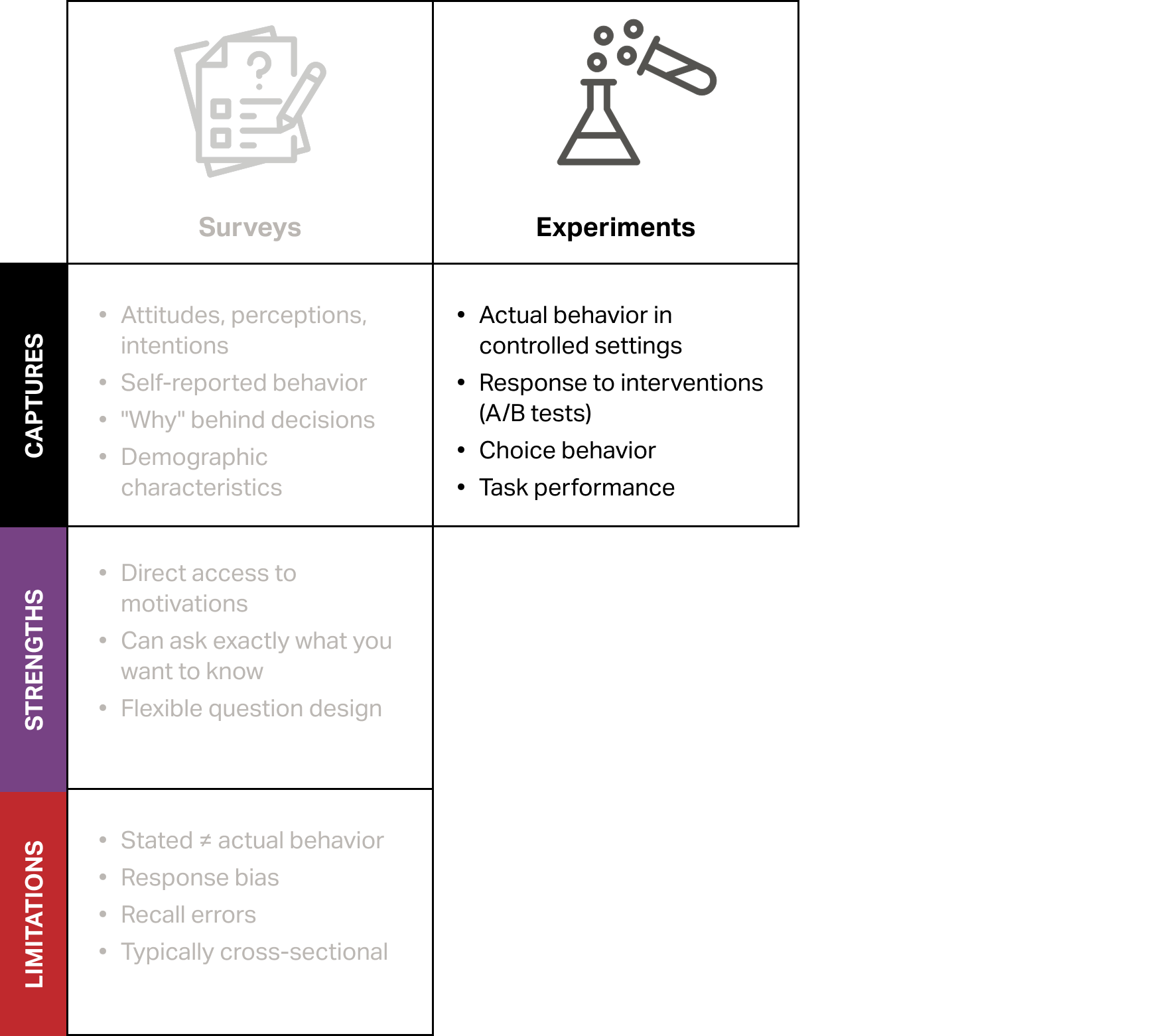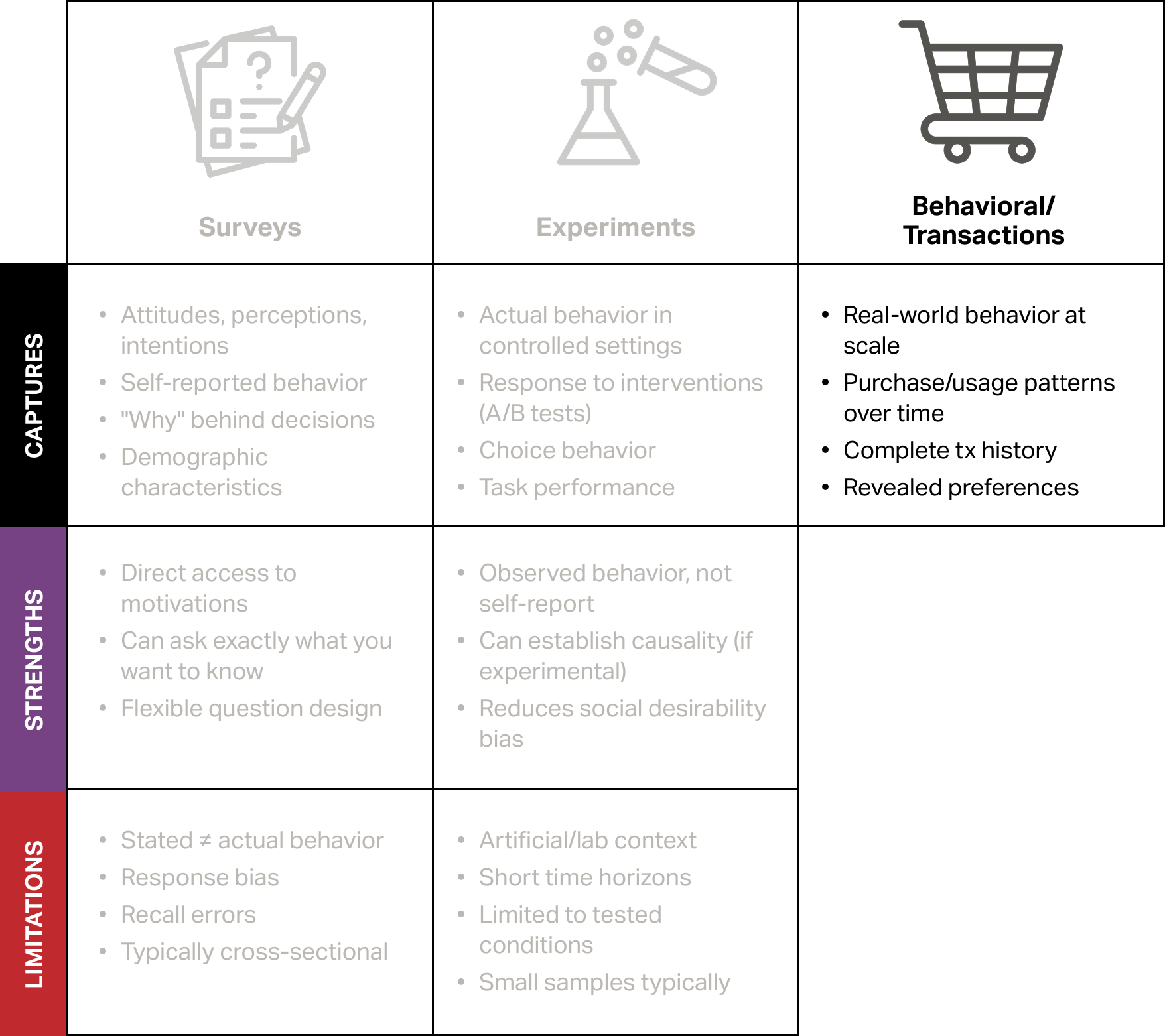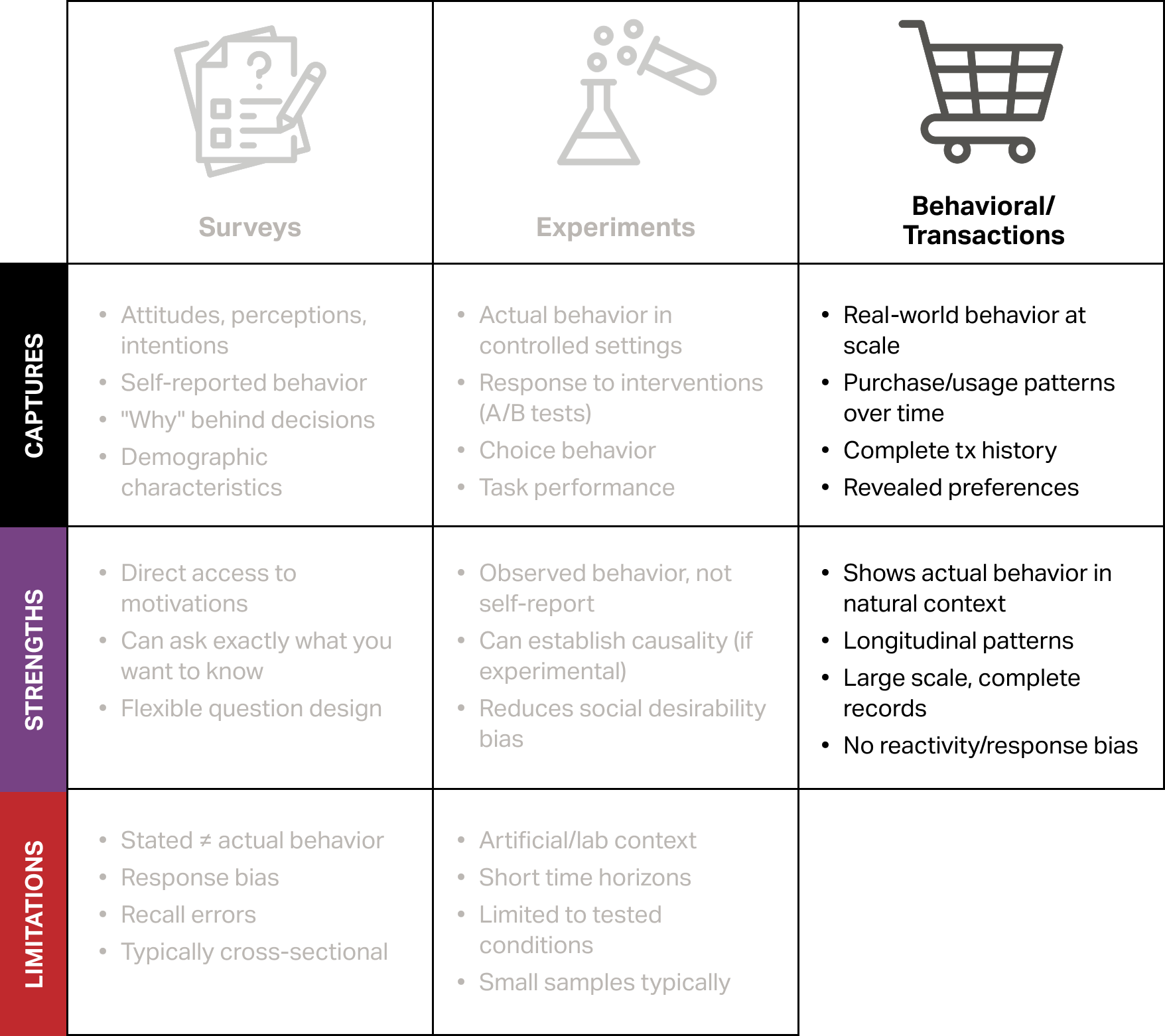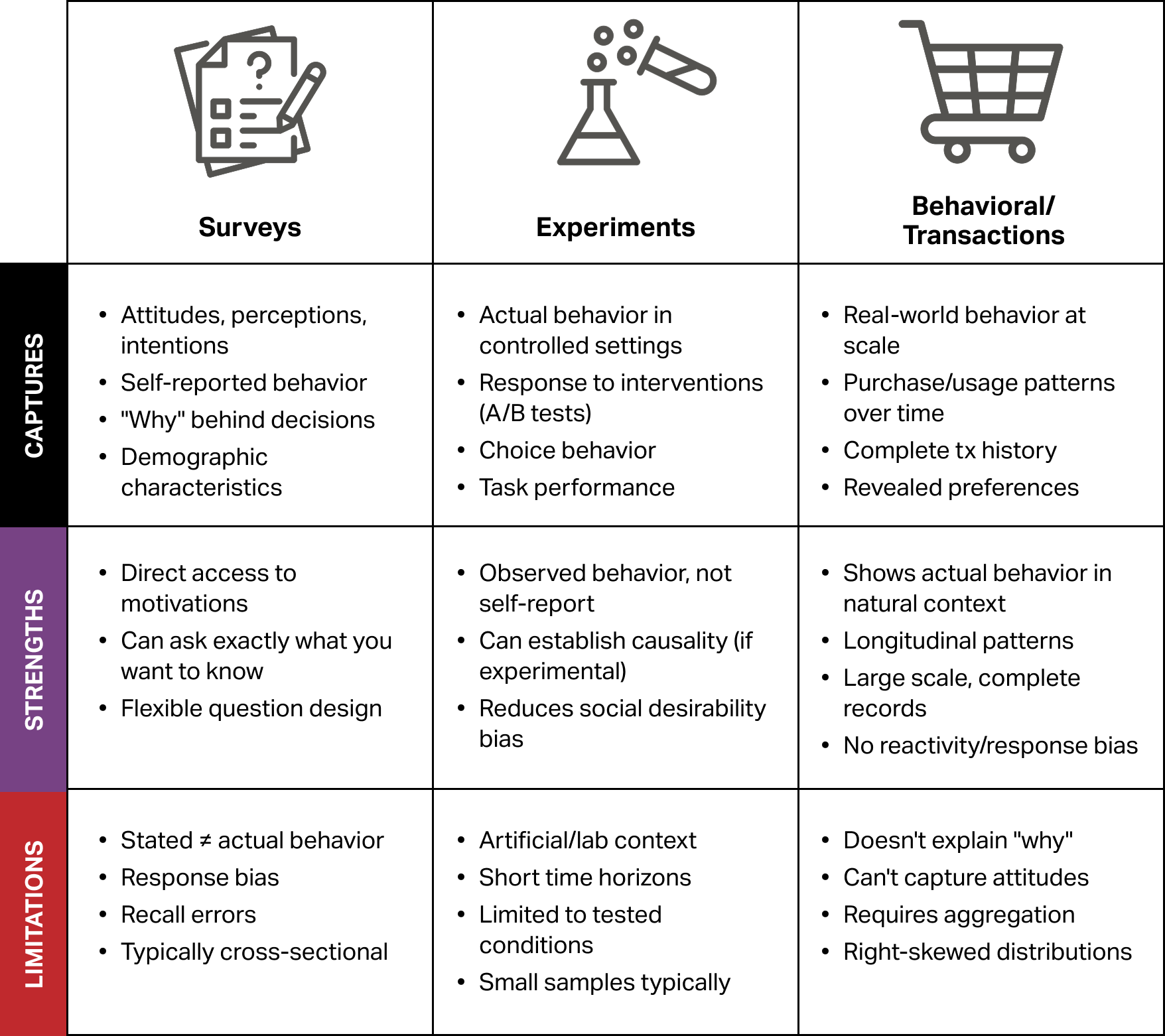
Working with Behavioral Data
Overview
Learning about customers through the data collected through business and relationship management systems.
Larry Vincent,
Professor of the Practice, Marketing
MKT 512
October 22, 2025

Behavioral data and customer profiling
Comparing options

Comparing options

Comparing options

Comparing options

Comparing options

Comparing options

Comparing options

Comparing options

Comparing options

Comparing options

Stated preferences vs. revealed
Stated preferences vs. revealed


Most used behavior metrics
- Recency–How recently have they engaged with us?

Most used behavior metrics
- Recency–How recently have they engaged with us?
- Frequency–How often do they tend to engage with us?


Most used behavior metrics
- Recency–How recently have they engaged with us?
- Frequency–How often do they tend to engage with us?
- Velocity–Is their behavior accelerating, declining or stable?



Most used behavior metrics
- Recency–How recently have they engaged with us?
- Frequency–How often do they tend to engage with us?
- Velocity–Is their behavior accelerating, declining or stable?
- Monetary–How much do they typically spend or how much have they spent since originating?




Sample data
We will be working with a synthetic data set for a fictional company. The data set has four columns, transaction_id, customer_id, transaction_date, and transaction_amount.
File: customer-transactions-data.csv
| transaction_id | customer_id | transaction_date | transaction_amount |
|---|---|---|---|
| TXN0000001 | CUST04313 | 2023-01-01 | 118.43 |
| TXN0000002 | CUST00041 | 2023-01-02 | 111.25 |
| TXN0000003 | CUST00152 | 2023-01-02 | 118.83 |
| TXN0000004 | CUST00293 | 2023-01-02 | 54.96 |
| TXN0000005 | CUST00341 | 2023-01-02 | 139.38 |
| TXN0000006 | CUST00498 | 2023-01-02 | 83.58 |
Transforming to customer data
# Set a cutoff point--here it's the day after the last transaction date
ANALYSIS_DATE <- as_date("2025-10-01")
# Group by customer to calculate customer behaviors
customers_df <- df |>
group_by(customer_id) |>
summarise(
last_transaction = max(transaction_date),
recency = as.numeric(ANALYSIS_DATE - last_transaction),
frequency = n(),
monetary = sum(transaction_amount),
avg_tx = mean(transaction_amount)
)Transforming to customer data
# Set a cutoff point--here it's the day after the last transaction date
ANALYSIS_DATE <- as_date("2025-10-01")
# Group by customer to calculate customer behaviors
customers_df <- df |>
group_by(customer_id) |>
summarise(
last_transaction = max(transaction_date),
recency = as.numeric(ANALYSIS_DATE - last_transaction),
frequency = n(),
monetary = sum(transaction_amount),
avg_tx = mean(transaction_amount)
)# A tibble: 6 × 6
customer_id last_transaction recency frequency monetary avg_tx
<chr> <date> <dbl> <int> <dbl> <dbl>
1 CUST00001 2025-01-01 273 4 318. 79.5
2 CUST00002 2025-07-15 78 4 279. 69.8
3 CUST00003 2025-09-26 5 18 1952. 108.
4 CUST00004 2025-09-06 25 19 1728. 90.9
5 CUST00005 2025-09-11 20 8 787. 98.4
6 CUST00006 2025-09-24 7 66 14967. 227. Recency
Recency
The number of days (or time period) since a customer’s last transaction or interaction.
Decay curve
Customer repurchase probability decays over time, though the rate varies dramatically by category (fast-moving consumer goods decay quickly; durable goods like appliances show flat patterns).

Analyzing recency patterns
Notice the concentration of customers with recent purchases (left side) and the long tail of inactive customers extending to the right—this pattern suggests most customers are engaged, but you have a significant inactive segment requiring re-engagement strategies.

Predictive Models
Recency scores can help us understand common patterns and probability of purchase within certain windows. These probabilities can be used to optimize marketing mix decisions.

Recency needs context
Two customers with same recency (30 days)

Customer A: Second purchase in < 30 days
→ Promising new customer

Customer B: Only purchase in 2 years
→ At-risk, declining customer
We need additional context
- How often do they engage?
- How much do they spend?
- Are they accelerating or declining?
With this context, you can then develop strategy.
- Winback lapsing and at-risk customers or take the win but don’t waste resources on inconsistent or opportunistic customers
- Incentivize return visit from new customer or target for special offer/reward
Next: Frequency as the second behavioral dimension
Frequency
Frequency
The number of transactions or interactions a customer has made within a specified time period.
Frequency as count data
Frequency is count data (integers ≥ 0), which requires specialized statistical methods. When the variance exceeds the mean (overdispersion) or there’s excess zeros, negative binomial or zero-inflated models are more appropriate than standard linear regression.
Properties of Count Data:
- Only non-negative integers (0, 1, 2, 3…)
- Cannot be averaged meaningfully
- Variance often increases with mean
- Excess zeros common (many one-time purchasers)
Statistical approaches:
- Poisson regression (if mean ≈ variance)
- Negative binomial (if overdispersed)
- Zero-inflated models (if excess zeros)

Frequency is context-dependent
What constitutes “high frequency” varies dramatically by business model and product category. A metric that signals engagement in one industry may indicate completely different behavior in another.
| Business Model | High Frequency | Interpretation |
|---|---|---|
| Coffee Shop | 20+ visits/month | Daily regular |
| Grocery Store | 2-3 visits/week | Weekly shopper |
| E-commerce Fashion | 8-12 orders/year | Fashion enthusiast |
| SaaS (B2B) | Daily logins | Power user |
| Luxury Auto | 1 purchase/5 years | Repeat customer (rare!) |
| Streaming Service | Daily usage | Core subscriber |
Count data requires care
Linear regression on count data produces nonsensical prediction intervals that include negative frequencies—an impossibility for count data.
# Wrong approach: Linear model
lm_model <- lm(frequency ~ recency + monetary,
data = customers_df)
# Prediction intervals
predict(lm_model, interval = "prediction")
# Right approach: Negative binomial
# using glm.nb function from MASS package
nb_model <- glm.nb(frequency ~ recency + monetary,
data = customers_df)Key Problem: Linear model assumes constant variance and normal errors—both violated with count data.

Monetary value
Monetary value
The financial dimension of customer behavior, revealing spending patterns, preferences, and relationship depth beyond simple revenue totals
Beyond the total
Customer Profile
Lifetime Spend:
$5,240
Transactions:
60
Time Period:
36 months

All revenue is not equal
Identical revenue ($10,000), completely different relationships and strategies needed

Revenue ≠ Value
Behavioral patterns (discount seeking, returns) directly impact true value

Stable is not a straight line

Lean in on expansion

Contraction is a red flag

Seasonal cases can be tricky

Takeaway
- Monetary metrics are behavioral signals
- Patterns reveal relationship depth, preferences, and trajectory
- Understanding how customers spend is as important as how much
Next: Velocity — quantifying behavioral change over time
Velocity
Velocity
The rate of change in customer behavior over time, revealing whether engagement is accelerating, decelerating, or stable.
Velocity takes many forms
Context determines which velocity metric matters most for your business
Engagement Velocity
- Login frequency trends
- Content consumption patterns
- Feature usage intensity
- Session duration changes
Transaction Velocity
- Purchase frequency changes
- Time between orders
- Repeat purchase acceleration
Spending Velocity
- Average order value trends
- Basket size growth
- Wallet share expansion
Measuring engagement velocity

Calculating velocity
Simple approach
Period-over-period change
- Week 1-4 average: 8 sessions
- Week 9-12 average: 14 sessions
Velocity = +75% growth
✓ Easy to calculate
✓ Intuitive to interpret
⚠️ Sensitive to outliers
Patterns vs. implications

Real-world velocity metrics
The specific metric varies, but the concept is universal: behavior change over time
Streaming (Netflix, Spotify)
- Hours streamed per week
- Content starts per session
- Days active per month
- Genre exploration rate
SaaS Products
- Daily/weekly active users
- Feature adoption rate
- Time in application
- Collaboration events
E-commerce
- Days between purchases
- Browse-to-buy conversion
- Category expansion
- Cart value trajectory
Social Platforms
- Posts/comments per week
- Connection growth rate
- Engagement with content
- Time on platform
Takeaway
- Velocity adds the temporal dimension
- Static metrics show where customers are → Velocity shows
where they’re going - Early warning system for churn and expansion opportunities
Next: Bringing it together with RFM scoring
RFM Analysis
RFM Analysis
Combining recency, frequency, and monetary metrics to create actionable customer segments for strategic marketing decisions.
Why combine R, F, and M?
Each dimension alone provides incomplete information. Combined, they reveal distinct customer archetypes requiring different strategies.
Recency alone:
Can’t distinguish new customers from declining ones
Frequency alone:
Misses spending power and engagement timing
Monetary alone:
Ignores relationship trajectory and engagement patterns

Creating RFM scores
Customers are ranked and divided into groups (typically 3-5) for each dimension, creating a composite score that enables segmentation.
Scoring Approaches:
Quintiles (5-point scale) - Divide customers into 5 equal groups - Score 5 = top 20%, Score 1 = bottom 20% - Creates 125 possible combinations (5³) - More granular, harder to interpret
Tertiles (3-point scale) - Divide customers into 3 equal groups
- Score 3 = top 33%, Score 1 = bottom 33% - Creates 27 possible combinations (3³) - Less precision, easier to act on
# 5-point RFM scoring
customers_rfm <- customers_df %>%
mutate(
R_score = ntile(desc(recency), 5),
F_score = ntile(frequency, 5),
M_score = ntile(monetary, 5),
RFM_score = paste0(R_score, F_score, M_score)
)
# 3-point RFM scoring
customers_rfm <- customers_df %>%
mutate(
R_score = ntile(desc(recency), 3),
F_score = ntile(frequency, 3),
M_score = ntile(monetary, 3),
RFM_score = paste0(R_score, F_score, M_score)
)Score distribution example
Understanding how customers distribute across RFM scores helps identify your most important segments and potential opportunities.

From scores to segments
Individual RFM scores are aggregated into business-relevant segments using rules-based logic, enabling targeted strategies for each customer group.
# Champions: High on all dimensions
champions <- filter(customers_rfm, R_score >= 4 & F_score >= 4 & M_score >= 4)
# Loyal: High F and M, decent R
loyal <- filter(customers_rfm, F_score >= 4 & M_score >= 4 & R_score >= 2)
# At-Risk: Were good (high F/M) but recency dropped
at_risk <- filter(customers_rfm, F_score >= 3 & M_score >= 3 & R_score <= 2)
# Promising: Recent but unproven
promising <- filter(customers_rfm, R_score >= 4 & F_score <= 2)
# Lost: Low on all dimensions
lost <- filter(customers_rfm, R_score <= 2 & F_score <= 2 & M_score <= 2)Common RFM segments
Standard segment archetypes provide a starting framework, though specific definitions should be customized to your business context and customer lifecycle.
| Segment | Typical RFM Pattern | Behavior Profile | Strategy Focus |
|---|---|---|---|
| Champions | 555, 554, 544 | Best customers: recent, frequent, high-value | Retention, VIP treatment, advocacy |
| Loyal Customers | X54, X55 (any R) | High value but may not be recent | Re-engagement, loyalty programs |
| Potential Loyalists | 453, 354, 353 | Recent, showing promise, building engagement | Accelerate frequency, increase basket |
| At Risk | 255, 254, 155 | Previously valuable, declining recency | Win-back campaigns, special offers |
| Need Attention | 333, 233, 323 | Moderate on all dimensions, unclear trajectory | Targeted nudges, prevent decline |
| Promising | 511, 411, 311 | Recent first-time or low-frequency buyers | Onboarding, second purchase incentive |
| Hibernating | 244, 155, 154 | Long inactive but had some historical value | Aggressive win-back or deprioritize |
| Lost | 111, 112, 121 | Unlikely to return, minimal engagement | Win-back with cost constraints or ignore |
Segment profile analysis
Profiling segments by size, revenue contribution, and average metrics validates segmentation logic and informs resource allocation decisions.

RFM limitations
While powerful for segmentation, RFM has constraints that more sophisticated clustering techniques can address in advanced analysis.
What RFM Does Well
- Simple, interpretable framework
- Actionable segments with clear logic
- Works with minimal data requirements
- Business stakeholders understand it
- Computationally efficient
- Good baseline for many businesses
What RFM Misses
- Arbitrarily groups continuous variables
- Loses information in discretization
- Can’t capture complex, non-linear patterns
- Fixed rules may not fit all customers
- Ignores product/category preferences
- No statistical validation of segments
- Misses velocity and trajectory nuances
Takeaway
- RFM transforms individual metrics into strategic segments
- Provides actionable framework for differentiated marketing
- Foundation for understanding customer value and lifecycle
- Starting point for more sophisticated analytical approaches
